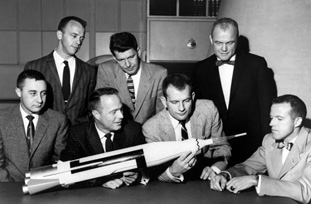The original seven Mercury astronauts look at a model of the rocket that would eventually launch their Mercury capsules into space. From the left, front row: Virgil "Gus" Grissom, Scott Carpenter, Donald "Deke" Slayton, Gordon Cooper. From the left, back row: Alan Shepard, Walter Schirra, John Glenn.
Click on image for full size
Image courtesy of NASA
John Glenn Receives Another 'Go'!
News story originally written on January 19, 1998
In 1959, John Glenn was chosen to be a Project Mercury Astronaut. In fact, he was given "go" to pilot the Mercury-Atlas 6 'Friendship 7' spacecraft on the first manned orbital mission of the United States of America. Some things haven't changed since the 60's - Glenn still has the right stuff!
NASA announced Friday that Glenn, who is 76 years old, will fly on the shuttle Discovery to be launched in October. This upcoming flight will be much different than his last flight 36 years ago. The Discovery mission will last 10 days, not just five hours. This time Glenn will be part of a seven person team, not flying solo. Unlike the Mercury mission which focused on survival, the Discovery mission will focus on how people age in space.
"Not only is John Glenn a Marine test pilot, an astronaut, and the first American to orbit the Earth, he brings a unique blend of experience to NASA," said NASA Administrator Daniel S. Goldin. "He has flight, operational, and policy experience. Unlike most astronauts, he never got the opportunity for a second flight. He is part of the NASA family, an American hero, and he has the right stuff for this mission."
You might also be interested in:

The Space Shuttle Discovery lifted off from Kennedy Space Center at 2:19 p.m. EST, October 29th. The sky was clear and the weather was great as Discovery took 8 1/2 minutes to reach orbit for the Unitied
...more
It was another exciting and frustrating year for the space science program. It seemed that every step forward led to one backwards. Either way, NASA led the way to a great century of discovery. Unfortunately,
...more
A moon was discovered orbiting the asteroid, Eugenia. This is only the second time in history that a satellite has been seen circling an asteroid. A special mirror allowed scientists to find the moon
...more
Will Russia ever put the service module for the International Space Station in space? NASA officials are demanding an answer from the Russian government. The necessary service module is currently waiting
...more
During a period of about two days in early May, 1998, the ACE spacecraft was immersed in plasma associated with a coronal mass ejection (CME). The SWICS instrument on ACE, which determines unambiguously
...more
J.S. Maini of the Canadian Forest Service has referred to forests as the "heart and lungs of the world." Forests reduce soil erosion, maintain water quality, contribute to atmospheric humidity and cloud
...more
In late April through mid-May 2002, all five naked-eye planets are visible simultaneously in the night sky! This is includes Mercury which is generally very hard to see because of its proximity to the
...more















